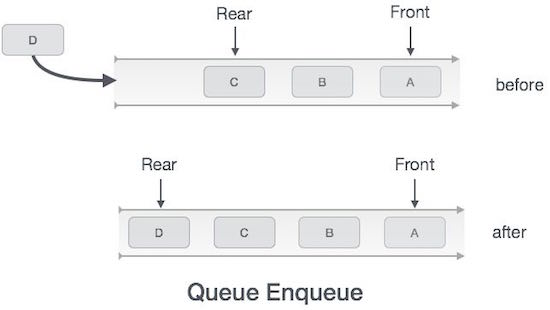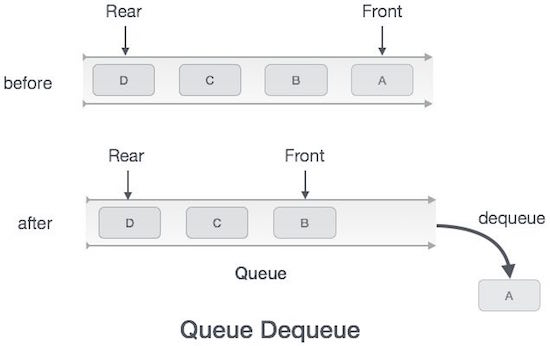Queue is an abstract data structure, somewhat similar to Stacks.
Unlike stacks, a queue is open at both its ends. One end is always used
to insert data (enqueue) and the other is used to remove data (dequeue).
Queue follows First-In-First-Out methodology, i.e., the data item
stored first will be accessed first.
 A real-world example of queue can be a single-lane one-way road,
where the vehicle enters first, exits first. More real-world examples
can be seen as queues at the ticket windows and bus-stops.
A real-world example of queue can be a single-lane one-way road,
where the vehicle enters first, exits first. More real-world examples
can be seen as queues at the ticket windows and bus-stops.
 As in stacks, a queue can also be implemented using Arrays,
Linked-lists, Pointers and Structures. For the sake of simplicity, we
shall implement queues using one-dimensional array.
As in stacks, a queue can also be implemented using Arrays,
Linked-lists, Pointers and Structures. For the sake of simplicity, we
shall implement queues using one-dimensional array.
Let's first learn about supportive functions of a queue −
Algorithm
Example
Algorithm
Example
Algorithm
Here's the C programming code −
Example
The following steps should be taken to enqueue (insert) data into a queue −
 Sometimes, we also check to see if a queue is initialized or not, to handle any unforeseen situations.
Sometimes, we also check to see if a queue is initialized or not, to handle any unforeseen situations.
Algorithm for enqueue operation
Example
 Algorithm for dequeue operation
Algorithm for dequeue operation
Example
 A real-world example of queue can be a single-lane one-way road,
where the vehicle enters first, exits first. More real-world examples
can be seen as queues at the ticket windows and bus-stops.
A real-world example of queue can be a single-lane one-way road,
where the vehicle enters first, exits first. More real-world examples
can be seen as queues at the ticket windows and bus-stops.Queue Representation
As we now understand that in queue, we access both ends for different reasons. The following diagram given below tries to explain queue representation as data structure − As in stacks, a queue can also be implemented using Arrays,
Linked-lists, Pointers and Structures. For the sake of simplicity, we
shall implement queues using one-dimensional array.
As in stacks, a queue can also be implemented using Arrays,
Linked-lists, Pointers and Structures. For the sake of simplicity, we
shall implement queues using one-dimensional array.Basic Operations
Queue operations may involve initializing or defining the queue, utilizing it, and then completely erasing it from the memory. Here we shall try to understand the basic operations associated with queues −- enqueue() − add (store) an item to the queue.
- dequeue() − remove (access) an item from the queue.
- peek() − Gets the element at the front of the queue without removing it.
- isfull() − Checks if the queue is full.
- isempty() − Checks if the queue is empty.
Let's first learn about supportive functions of a queue −
peek()
This function helps to see the data at the front of the queue. The algorithm of peek() function is as follows −Algorithm
begin procedure peek return queue[front] end procedureImplementation of peek() function in C programming language −
Example
int peek() { return queue[front]; }
isfull()
As we are using single dimension array to implement queue, we just check for the rear pointer to reach at MAXSIZE to determine that the queue is full. In case we maintain the queue in a circular linked-list, the algorithm will differ. Algorithm of isfull() function −Algorithm
begin procedure isfull if rear equals to MAXSIZE return true else return false endif end procedureImplementation of isfull() function in C programming language −
Example
bool isfull() { if(rear == MAXSIZE - 1) return true; else return false; }
isempty()
Algorithm of isempty() function −Algorithm
begin procedure isempty if front is less than MIN OR front is greater than rear return true else return false endif end procedureIf the value of front is less than MIN or 0, it tells that the queue is not yet initialized, hence empty.
Here's the C programming code −
Example
bool isempty() { if(front < 0 || front > rear) return true; else return false; }
Enqueue Operation
Queues maintain two data pointers, front and rear. Therefore, its operations are comparatively difficult to implement than that of stacks.The following steps should be taken to enqueue (insert) data into a queue −
- Step 1 − Check if the queue is full.
- Step 2 − If the queue is full, produce overflow error and exit.
- Step 3 − If the queue is not full, increment rear pointer to point the next empty space.
- Step 4 − Add data element to the queue location, where the rear is pointing.
- Step 5 − return success.
 Sometimes, we also check to see if a queue is initialized or not, to handle any unforeseen situations.
Sometimes, we also check to see if a queue is initialized or not, to handle any unforeseen situations.Algorithm for enqueue operation
procedure enqueue(data) if queue is full return overflow endif rear ← rear + 1 queue[rear] ← data return true end procedureImplementation of enqueue() in C programming language −
Example
int enqueue(int data) if(isfull()) return 0; rear = rear + 1; queue[rear] = data; return 1; end procedure
Dequeue Operation
Accessing data from the queue is a process of two tasks − access the data where front is pointing and remove the data after access. The following steps are taken to perform dequeue operation −- Step 1 − Check if the queue is empty.
- Step 2 − If the queue is empty, produce underflow error and exit.
- Step 3 − If the queue is not empty, access the data where front is pointing.
- Step 4 − Increment front pointer to point to the next available data element.
- Step 5 − Return success.
 Algorithm for dequeue operation
Algorithm for dequeue operationprocedure dequeue if queue is empty return underflow end if data = queue[front] front ← front + 1 return true end procedureImplementation of dequeue() in C programming language −
Example
int dequeue() { if(isempty()) return 0; int data = queue[front]; front = front + 1; return data; }For a complete Queue program in C programming language, please click here.

No comments:
Post a Comment